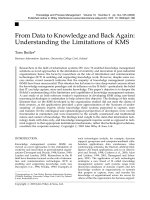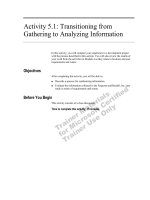The math book from pythagoras to the 57th dimension
Bạn đang xem bản rút gọn của tài liệu. Xem và tải ngay bản đầy đủ của tài liệu tại đây (47.59 MB, 534 trang )
_w._rfI_"D"_,,, .....
N. .
Ant Odometer
Ants are social insects that evolved from vespoid wasps in the mid-Cretaceous period,
about 150 million years ago. After the rise of flowering plants, about 100 million years
ago, ants diversified into numerous species.
The Saharan desert ant, Cataglyphis {ortis, travels immense distances over
sandy terrain, often completely devoid of landmarks. as it searches for food. These
creatures are able to return to their nest using a direct route rather than by retracing
their outbound path. Not only do they judge directions, using light from the sky for
orientation, but they also appear to have a built-in "computer" that functions like a
pedometer that counts their steps and allows them to measure exact distances. An
ant may travel as far as 160 feet (about 50 meters) until it encounters a dead insect,
whereupon it tears a piece to carry directly back to its nest, accessed via a hole often less
than a millimeter in diameter.
By manipulating the leg lengths of ants to give them longer and shorter strides, a
research team of German and Swiss scientists discovered that the ants "count" steps
to judge distance. For example, after ants had reached their destination, the legs were
lengthened by adding stilts or shortened by partial amputation. The researchers then
returned the ants so that the ants could start on their journey back to the nest. Aots with
the stilts traveled too far and passed the nest entrance, while those with the amputated
legs did not reach it. However, if the ants started their journey from their nest with the
modified legs, they were able to compute the appropriate distances. This suggests that
stride length is the crucial factor. Moreover. the highly sophisticated computer in the
ant's brain enables the ant to compute a quantity related to the horizontal projection of
its path so that it does not become lost even if the sandy landscape develops hills and
valleys during its journey.
SEE ALSO Primates Count (c. 30 MiUion B.C. ) and Cicada-Cenerated Prime Numbers (c I Million B.G).
Saharan desert ants may have built-in "pedometers" that count steps and allow the ants to measure exact
distances. Ants with stilts glued to their legs (shown in red) traYel too far and pass their nest entrance, ruggesting
that stnde length is important {or distance determination.
18
Primates Count
Around 60 million years ago, small, lemur-like primates had evolved ill mallY areas
of the world, and 30 million years ago, primates with monkeylike characteristics
existed. Could such creatures count? The meaning of counting by animals is a highly
contentious issue among animal behavior experts. However, many scholars suggest that
animals have some sense of number. H. Kalmus writes in his Nature article" Animals as
Mathematicians":
There is now little doubt that some animals such as squirrels or parrots can be
trained to count. ... Counting faculties have been reported in squirrels, rats, and
for pollinating insects. Some of these animals and others can distinguish numbers
in otherwise similar visual patterns, while others can be trained to recognize and
even to reproduce sequences of acoustic signals. A few can even be trained to tap
out the numbers of elements (dots) in a visual pattern .... The lack of the spoken
numeral and the written symbol makes many people reluctant to accept animals
as mathematicians.
Rats have been shown to count" by performing an activity the correct number of times
OJ
in exchange for a reward. Chimpanzees can press numbers on a computer that match
numbers of bananas in a box. Testsuro Matsuzawa of the Primate Research Institute
at Kyoto University in Japan taught a chimpanzee to identify numbers from I to 6 by
pressing the appropriate computer key when she was shown a certain number of objects
on the computer screen.
Michael Beran, a research scientist at Georgia State University in Atlanta, Georgia,
trained chimps to use a computer screen and joystick. The screen flashed a numeral
and then a series of dots. and the chimps had to match the two. One chimp learned
numerals I to 7, while another managed to count to 6. When the chimps were tested
again after a gap of three years, both chimps were able to match numbers, but with
double the error rate.
SEE ALSO Ant Odometer (c. 150 MiI1ion B.C.) and Ishango Bone (c 18,000 B C.)
Primates appear to have some sense of number, and the higher primates can be taught to identify numbers {rom
, to 6 by pressing the appropriate computer key when shown a ceriain number of objects.
20









